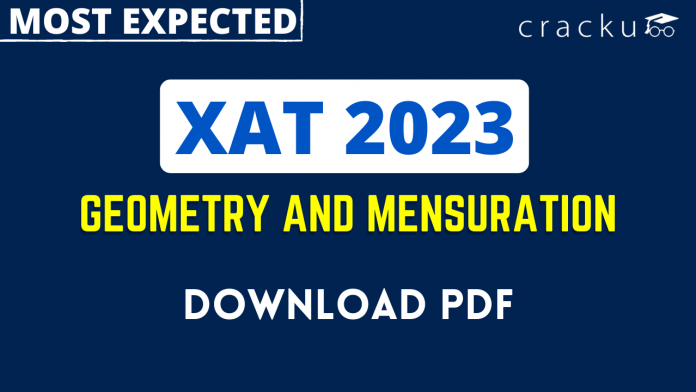XAT Geometry and Mensuartion Questions [Download PDF]
Download Geometry and Mensuration Questions for XAT PDF – XAT Geometry and Mensuration questions PDF by Cracku. Practice XAT solved Geometry and Mensuration Questions paper tests, and these are the practice question to have a firm grasp on the Geometry and Mensuration topic in the XAT exam. Top 20 very Important Geometry and Mensuration Questions for XAT based on asked questions in previous exam papers. The XAT question papers contain actual questions asked with answers and solutions.
Download Geometry and Mensuartion Questions for XAT
Enroll to XAT 2023 Crash Course
Question 1: If the height of a triangle is decreased by 40% and it’s base is increased by 40% , what will be the effect on its area?
a) No change
b) 16 % increase
c) 8% decrease
d) 16% decrease
e) None of these
1) Answer (D)
Solution:
area of triangle = 1/2(base*height)
after decreasing height by 40%, new height = 0.6H
after increasing base by 40%, new base = 1.4B
now, area of triangle = 1/2(1.4B*0.6H) = 0.84(1/2*B*H)
Area decreased by 100-84%= 16%
so the answer is option D.
Question 2: A circular Ground whose diameter is 35 meters has a 1.4 meters broad garden around it.What is the area of the garden in square meters ?
a) 160.16
b) 6.16
c) 1122.66
d) Data Inadequate
e) None of these
2) Answer (A)
Solution:
Radius of circular ground = $r = \frac{35}{2}=17.5$ m and width of broad garden = 1.4 m
=> Radius of outer circle (ground+garden), R = 17.5 + 1.4 = 18.9 m
Area of garden = Area of outer circle – Area of inner circle
= $\pi R^2-\pi r^2 = \pi(R-r)(R+r)$
= $\frac{22}{7}(18.9-17.5)(18.9+17.5)$
= $\frac{22}{7} \times 1.4 \times 36.4$
= $22 \times 0.2 \times 36.4 = 160.16$ $m^2$
=> Ans – (A)
Question 3: The top of 15 meters high tower makes an angle of depression of 60 degrees with the bottom of a electric pole and an angle of 30 degrees with the top of the pole. What is the height of the electric pole?
a) 5 meters
b) 8 meters
c) 10 meters
d) 12 meters
e) None of these
3) Answer (C)
Solution:

AD is the tower = 15 m and CE is the electric pole
Let AB = $x$ m and DE = BC = $y$ m
Also, $\angle$ AED = 60° and $\angle$ ACB = 30°
In $\triangle$ ADE, => $tan(\angle AED)=\frac{AD}{DE}$
=> $tan(60)=\sqrt{3}=\frac{15}{y}$
=> $y=\frac{15}{\sqrt{3}}=5\sqrt{3}$ m
In $\triangle$ ABC, => $tan(\angle ACB)=\frac{AB}{BC}$
=> $tan(30)=\frac{1}{\sqrt{3}}=\frac{x}{5\sqrt{3}}$
=> $x=5$ m
$\therefore$ CE = AD – AB = 15 – 5 = 10 meters
=> Ans – (C)
Question 4: If the height of a triangle is decreased by 40% and it’s base is increased by 40% , what will be the effect on its area?
a) No change
b) 16 % increase
c) 8% decrease
d) 16% decrease
e) None of these
4) Answer (D)
Solution:
Let base and height of the triangle be 10 cm each
Area of original triangle, $\triangle = \frac{1}{2} \times 10 \times 10 = 50$ $cm^2$
If the height of a triangle is decreased by 40%, => New height = $10-\frac{40}{100} \times 10=6$ cm
and it’s base is increased by 40%, => New base = $10+\frac{40}{100} \times 10=14$ cm
Area of new triangle, $\triangle’ = \frac{1}{2} \times 6 \times 14 = 42$ $cm^2$
$\therefore$ Area decreases by = $\frac{\triangle – \triangle’}{\triangle} \times 100$
= $\frac{50-42}{50} \times 100 = 8 \times 2=16\%$
=> Ans – (D)
Instructions
Read the following information and answer the questions based on it.
The length ,breadth and height of a rectangular piece of wood in the 4cm,3cm, 5cm respectively
Opposite side of 5cm x 4 cm pieces are coloured in red colour
Oppsite sides 4cm x 3 cm ,are cloured in blue
Rest 5 cm x 3 cm are coloured in green in both sides
Now the piece is cut in such way that a cuboid of 1cm x 1cm x 1cm will be made
Question 5: How many cuboids shall have all the three colours?
a) 8
b) 10
c) 12
d) 14
e) None of these
5) Answer (A)
Solution:

The number of cuboid which will have all the three colours are the corner pieces.
Thus, 8 cuboids will have all the three colours.
=> Ans – (A)
Question 6: How many cuboids shall not any colour?
a) No any
b) 2
c) 4
d) 6
e) None of these
6) Answer (D)
Solution:

Number of cuboids which do not have any colour = $(5-2) \times (4-2) \times (3-2)$
= $3 \times 2 \times 1=6$
=> Ans – (D)
Question 7: How many cuboids shall have only two colours red and green in their two sides?
a) 8
b) 12
c) 16
d) 20
e) None of these
7) Answer (B)
Solution:

Number of cuboids which have only two colours red and green in their two sides are the middle cuboids at the corner edges. There are 4 such edges which have combination of red and green colour.
Number of required cuboids = $(5-2) \times 4$
= $3 \times 4=12$
=> Ans – (B)
Question 8: How many cuboids shall have only one colour ?
a) 12
b) 16
c) 22
d) 28
e) None of these
8) Answer (E)
Solution:

Number of cuboids which have only 1 colour are the middle cuboids in all the faces. Also, there are 2 types of each faces.
2*(B-2)*(H-2)+2*(H-2)*(L-2).
=2*(4-2)*(3-2)+2*(3-2)*(5-2)+2*(5-2)*(4-2).
= 2*2*1 + 2*1*3 + 2*3*2.= 4 + 6 + 12.
=22.
Question 9: When the length of the rectangular plot is increased by four times its perimeter becomes 480 meters and area becomes 12800 sq.m. What is its original length(in meters)?
a) 160
b) 40
c) 20
d) Cannot be determined
e) None of these
9) Answer (D)
Solution:
Let the length of the plot be $l$ meters and breadth = $b$ meters
New length = $4l$ meters
Perimeter = $2(4l+b)=480$
=> $4l+b=\frac{480}{2}=240$
=> $b=240-4l$ ———(i)
Area = $(4l \times b)=12800$
=> $lb=\frac{12800}{4}=3200$
Substituting value of $b$ from equation (i)
=> $l(240-4l)=3200$
=> $240l-4l^2=3200$
=> $l^2-60l+800$
=> $l=\frac{-(-60) \pm \sqrt{(-60)^2-(4 \times 1 \times 800)}}{2}$
=> $l=\frac{60 \pm \sqrt{3600-3200}}{2} = \frac{60 \pm \sqrt{400}}{2}$
=> $l=\frac{60 \pm 20}{2}$
=> $l=\frac{60+20}{2},\frac{60-20}{2}$
=> $l=\frac{80}{2},\frac{40}{2}$
=> $l=40,20$ meters
=> Ans – (D)
Question 10: Four circles having equal radii are drawn with center at the four corners of a square. Each circle touches the other two adjacent circle. If remaining area of the square is 168 cm, what is the size of the radius of the radius of the circle? (in centimeters)
a) 14
b) 1.4
c) 38
d) 21
e) 3.5
10) Answer (A)
Solution:

Diameter of circle = side of square = $d$ cm
Area of square = $d^2$ sq. cm
Area of 1 quadrant = $\frac{1}{4} \times \pi \times (\frac{d}{2})^2$
= $\pi \times \frac{d^2}{16}$
=> Area of 4 quadrants = $4 \times \pi \times \frac{d^2}{16} = \frac{\pi d^2}{4}$ sq. cm
Area of shaded region = 168
=> $d^2 – \frac{\pi d^2}{4} = 168$
=> $\frac{1}{4} [d^2 (4 – \pi)] = 168$
=> $d^2 = \frac{168 \times 4}{4 – \pi} = \frac{168 \times 4}{4 – \frac{22}{7}}$
=> $d^2 = \frac{168 \times 4 \times 7}{28 – 22} = \frac{168}{6} \times 28$
=> $d = \sqrt{28 \times 28} = 28$ cm
$\therefore$ Radius = $\frac{28}{2} = 14$ cm
Question 11: The area of a right angled triangle is 80 sq. cm. The ratio of the base and the height of the triangle is 4 : 5. Find the length of hypotenuse.
a) 82cm
b) 2 82cm
c) 2 41cm
d) 3 82cm
e) None of these
11) Answer (E)
Solution:
Let base and height be $4x$ and $5x$ respectively.
Area of triangle = $\frac{1}{2} \times$ base $\times$ height = 80
=> $\frac{1}{2} \times 4x \times 5x = 80$
=> $x^2 = \frac{80}{10} = 8$
=> $x = \sqrt{8} = 2 \sqrt{2}$
=> Base = $8 \sqrt{2}$ and Height = $10 \sqrt{2}$
$\therefore$ Hypotenuse = $\sqrt{(8 \sqrt{2})^2 + (10 \sqrt{2})^2}$
= $\sqrt{128 + 200} = \sqrt{328}$
$\approx 18$ cm
Question 12: Area of a rectangle is equal to the area of the circle whose radius is 21 cms. If the length and the breadth of the rectangle are in the ratio of 14 : 11 respectively, what is its perimeter?
a) 142 cms.
b) 140 cms.
c) 132 ems.
d) 150 cms.
e) None of these
12) Answer (D)
Solution:
Radius of circle = 21 cm
=> Area of circle = $\pi r^2$
= $\frac{22}{7} \times 21 \times 21 = 1386 cm^2$
Thus, area of rectangle = $1386 cm^2$
Let length and breadth of rectangle be $14x$ and $11x$ respectively.
=> Area = $14x \times 11x = 1386$
=> $x^2 = \frac{1386}{154} = 9$
=> $x = \sqrt{9} = 3$ cm
$\therefore$ Perimeter = $2 (14x + 11x)$
= $2 \times 25x = 50x$
= $50 \times 3 = 150$ cm
Question 13: What would be the cost of building a fence around a square plot with area equal to 361 sq. ft. if the price per foot of building the fence is Rs. 62 ?
a) Rs. 4026
b) Rs. 4712
c) Rs. 3948
d) Cannot be determined
e) None of these
13) Answer (B)
Solution:
Let side of square plot = $s$ ft
=> Area = $s^2 = 361$
=> $s = \sqrt{361} = 19$ ft
Perimeter of square plot = $4 s = 4 \times 19 = 76$ ft
Cost of building fence per foot = Rs. 62
$\therefore$ Cost of building fence around the plot = $76 \times 62 = Rs. 4712$
Question 14: The sum of the dimensions of a room (i.e. length, breadth and height) is 18 metres and its length, breadth and height are in the ratio of 3 : 2 : 1 respectively. If the room is to be painted at the rate of Rs. 15 per m2, what would be the total cost incurred on painting only the four walls of the room (in Rs.)?
a) 3250
b) 2445
c) 1350
d) 2210
e) 2940
14) Answer (C)
Solution:
Let the dimension of the room be $3x , 2x , x$ metres
Acc. to ques, => $3x + 2x + x = 18$
=> $x = \frac{18}{6} = 3$ metres
Curved surface area of the room = $2 h (l + b)$
= $2 \times x \times (3x + 2x) = 2x \times 5x$
= $10 (x)^2 = 10 \times (3)^2$
= $10 \times 9 = 90 m^2$
$\therefore$ Total cost incurred on painting only the four walls of the room = $15 \times 90$
= $Rs. 1,350$
Question 15: The sum of the dimensions of a room (i.e. length, breadth and height) is 24 metres and its length, breadth and height are in the ratio of 8: 7 : 5 respectively. If the room is to be painted at the rate of Rs. 12 per m2, what would be the total cost incurred on painting only the four walls of the room (in Rs.)?
a) 2592
b) 2648
c) 2848
d) 2120
e) 1956
15) Answer (A)
Solution:
Let the dimension of the room be $8x , 7x , 5x$ metres
Acc. to ques, => $8x + 7x + 5x = 24$
=> $x = \frac{24}{20} = 1.2$ metres
Curved surface area of the room = $2 h (l + b)$
= $2 \times 5x \times (8x + 7x) = 10x \times 15x$
= $150 (x)^2 = 150 \times (1.2)^2$
= $150 \times 1.44 = 216 m^2$
$\therefore$ Total cost incurred on painting only the four walls of the room = $12 \times 216$
= $Rs. 2,592$
Question 16: It takes Rs. 3159 to plant synthetic grass in a square lawn, ${1 \over 4}$ of which is paved (and thus does not require grass). If each side of this lawn measures 18m, what is the rate that the gardener charges for planting synthetic grass? (in Rs./m²)
a) 18
b) 11
c) 16
d) 15
e) 13
16) Answer (E)
Solution:
Side of square lawn = 18 m
Part of the lawn that requires grass = $1 – \frac{1}{4} = \frac{3}{4}$
=> Area of the lawn that requires grass = $\frac{3}{4} \times (18)^2$
= $3 \times 9 \times 9 = 243 m^2$
Total amount to plant grass = Rs. 3159
$\therefore$ Rate that the gardener charges for planting synthetic grass = $\frac{3159}{243} = 13$
Question 17: If (11) is subtracted from the square of a number, the answer so obtained is 430. What is the number?
a) 36
b) 28
c) 21
d) 48
e) None of these
17) Answer (C)
Solution:
Let the number be $x$
According to ques,
=> $x^2-11 = 430$
=> $x^2=430+11=441$
=> $x=\sqrt{441}=21$
=> Ans – (C)
Question 18: Area of circle is equal to the area of a rectangle having perimeter of 50 cms. and length more than the breadth by 3 cms. What is the diameter of the circle?
a) 7 cms.
b) 21 cms.
c) 28 cms.
d) 14 cms.
e) None of these
18) Answer (D)
Solution:
Let the breadth of rectangle be $x$ cm
=> Length of rectangle = $(x + 3)$ cm
Now, perimeter = $2 (x + x + 3) = 50$
=> $2x + 3 = 25$
=> $x = \frac{22}{2} = 11$
Thus, breadth = 11 cm and length = 14 cm
$\because$ Area of circle = Area of rectangle
=> $\pi r^2 = 14 \times 11$
=> $r^2 = \frac{14 \times 11 \times 7}{22}$
=> $r = \sqrt{7 \times 7} = 7$ cm
$\therefore$ Diameter = 2 * 7 = 14 cm
Question 19: When 3888 is divided by the square of a number and the answer so obtained is multiplied by 21, the final answer obtained is 252. What is the number ?
a) 324
b) 16
c) 256
d) 144
e) None of these
19) Answer (E)
Solution:
Let the number be $x$
Acc to ques,
=> $\frac{3888}{x^2} \times 21 = 252$
=> $\frac{3888}{x^2} = 12$
=> $x^2 = \frac{3888}{12} = 324$
=> $x = \sqrt{324} = 18$
Question 20: If the perimeter of a rectangle is 180 metres and the difference between the length and the breadth is 8 metres, what is the area of the rectangle ?
a) 2116 square metres
b) 2047 square metres
c) 2090 square metres
d) 2178 square metres
e) None of these
20) Answer (E)
Solution:
Let length of rectangle = $x$ metre
and breadth = $(x – 8)$ metre
=> Perimeter = $2 (x + x – 8) = 180$
=> $2x – 8 = 90$
=> $x = \frac{98}{2} = 49$
=> Breadth = 49 – 8 = 41 metre
$\therefore$ Area of rectangle = 49 * 41 = 2009 sq. metre





